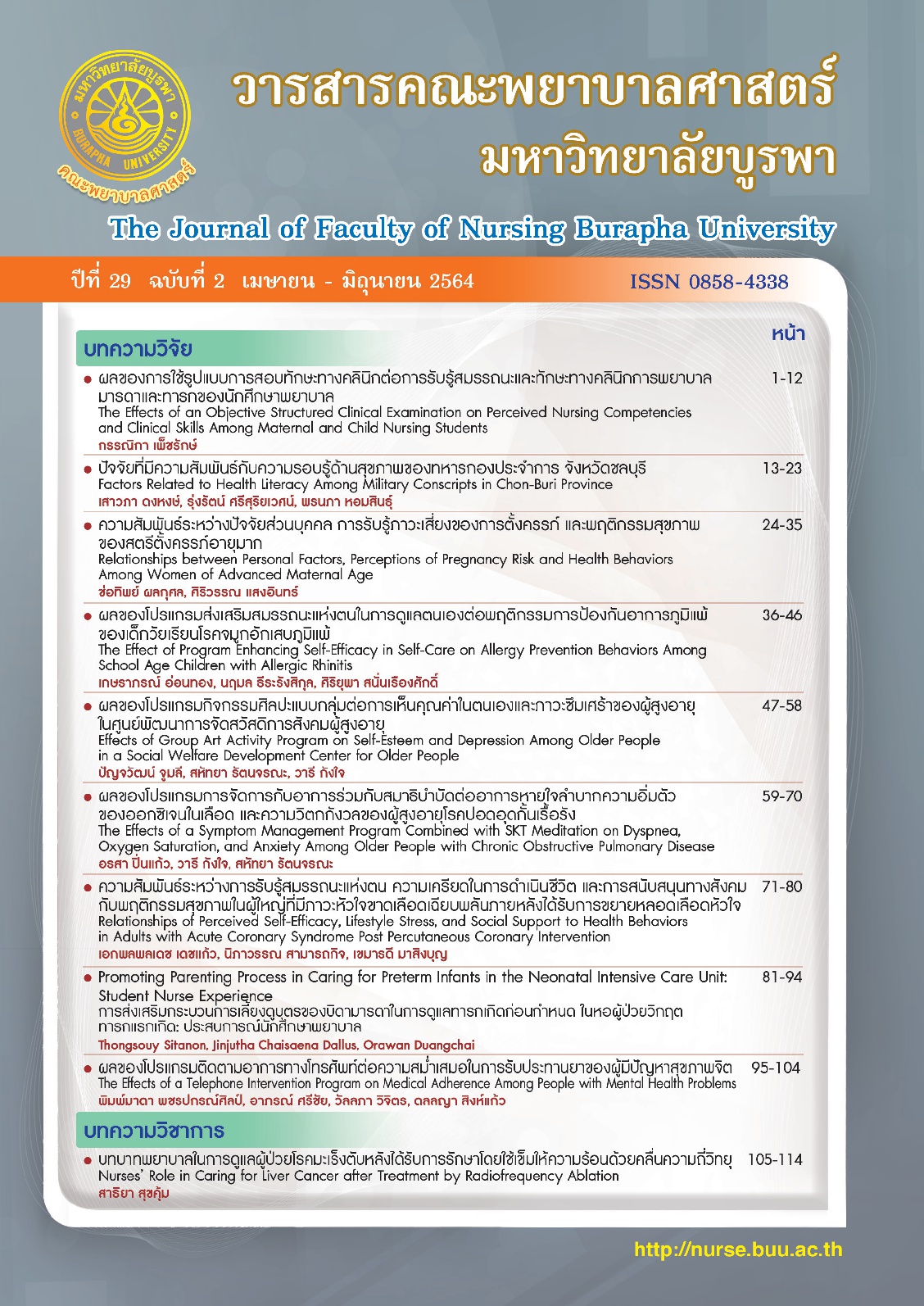ความสัมพันธ์ระหว่างการรับรู้สมรรถนะแห่งตน ความเครียดในการดำเนินชีวิต และการสนับสนุนทางสังคมกับพฤติกรรม สุขภาพในผู้ใหญ่ที่มีภาวะหัวใจขาดเลือดเฉียบพลันภายหลังได้รับ การขยายหลอดเลือดหัวใจ
คำสำคัญ:
พฤติกรรมสุขภาพ, ภาวะหัวใจขาดเลือดเฉียบพลัน, การรับรู้สมรรถนะแห่งตน, ความเครียดในการดำเนินชีวิต, การสนับสนุนทางสังคมบทคัดย่อ
การศึกษาครั้งนี้มีวัตถุประสงค์เพื่อศึกษาความสัมพันธ์ระหว่างการรับรู้สมรรถนะแห่งตน ความเครียดในการดำเนิน
ชีวิต และการสนับสนุนทางสังคมกับพฤติกรรมสุขภาพในผู้ใหญ่ที่มีภาวะหัวใจขาดเลือดเฉียบพลัน กลุ่มตัวอย่าง เป็นผู้ใหญ่
ที่มีภาวะหัวใจขาดเลือดเฉียบพลัน ภายหลังได้รับการขยายหลอดเลือดหัวใจ 6-12 เดือน ที่มาตรวจติดตามอาการ ณ
แผนกผู้ป่วยนอกคลินิกโรคหัวใจ โรงพยาบาลแห่งหนึ่ง สังกัดมหาวิทยาลัย i จำนวน 107 ราย สุ่มกลุ่มตัวอย่างโดยการ
กำหนดช่วงเวลา เก็บรวบรวมข้อมูลระหว่าง เดือนธันวาคม พ.ศ. 2563 ถึงเดือนมีนาคม พ.ศ. 2564 เครื่องมือวิจัยประกอบ
ด้วยแบบบันทึกข้อมูลทั่วไป แบบสอบถามพฤติกรรมสุขภาพ แบบสอบถามการรับรู้สมรรถนะแห่งตน แบบสอบถาม
การสนับสนุนทางสังคม และแบบสอบถามความเครียดในการดำเนินชีวิต ซึ่งมีค่าสัมประสิทธิ์แอลฟาของคอนบราค ที่
.85, .87, .95 และ .85 ตามลำดับ วิเคราะห์ข้อมูลด้วยสถิติพรรณนา และสัมประสิทธิ์สหสัมพันธ์ของเพียร์สัน ผลการวิจัย
พบว่า การรับรู้สมรรถนะแห่งตนและการสนับสนุนทางสังคมสัมพันธ์ทางบวกกับพฤติกรรมสุขภาพอย่างมีนัยสำคัญทาง
สถิติ (r = .714, p < .001; r = .639, p < .001 ตามลำดับ) และความเครียดในการดำเนินชีวิตสัมพันธ์ทางลบกับพฤติกรรม
สุขภาพอย่างมีนัยสำคัญทางสถิติ (r = -.658, p <.001)
ผลการวิจัยเสนอแนะว่า พยาบาลควรออกแบบการส่งเสริมให้ผู้ป่วยกลุ่มนี้มีการปรับเปลี่ยนพฤติกรรมสุขภาพ
โดยเน้นการเพิ่มการรับรู้สมรรถนะแห่งตน การสนับสนุนทางสังคม และลดความเครียดในการดำเนินชีวิต เพื่อป้องกัน
การกลับเป็นซ้ำและมีคุณภาพชีวิตที่ดีต่อไป
เอกสารอ้างอิง
American Heart Association. (2015). Heart disease and stroke statistics-2015 update: A report from the American Heart Association. Circulation, 131(4), e29-e322.
American Heart Association. (2020). Heart disease and stroke statistics-2020 update: A report from the American Heart Association. Circulation, 141(9), e139-e596.
Burns, N., & Grove, S. K. (2005). The practice of nursing research: Conduct, critique, and
utilization (5th ed.). Missouri: Elsevier Saunders.
Chaiwong, N., Duangpaeng, S., & Masingboon, K. (2014). Factors influencing self-management behaviors among acute myocardial infarction patients. Thai Pharmaceutical and Health Science Journal, 9(3), 112-119. [In Thai]
Cohen, S. (1988). Perceived stress in a probability sample of the United States. In The Social Psychology of Health. (pp. 31-67). Thousand Oaks, CA, US : Sage Publication, Inc.
Department of Disease Control, Ministry of Public Health Thailand. (2017). Annual report 2017. Retrieved From http://thaincd.com/2016/media-detail.php?id=12986&gid=1-015-008. [In Thai]
Department of Disease Control Ministry of Public Health Thailand. (2018). Coronary artery disease (CAD) situation in 2018. Retrieved From https://ddc.moph.go.th/uploads/fles/1081120191227091554.pdf. [In Thai]
Detkaew, A. (2021). Factors influencing health behaviors in adults with acute coronary syndrome post percutaneous coronary intervention. Thesis. Chonburi: Burapha University. [In Thai]
Dibao-Dina, C., Angoulvant, D., Lebeau, J. P., Peurois, J. E., Abdallah El Hirtsi, K., & Lehr-Drylewicz, A.-M. (2018). Patients’ adherence to optimal therapeutic, lifestyle and risk factors recommendations after myocardial infarction: Six years follow-up in primary care. PLOS ONE, 13(9), e0202986.
Jirawatkul, A. (2014). Statistics in research: Appropriate selection. Bangkok: Wittayapat publisher. [In Thai]
Kahkonen, O., Kankkunen, P., Miettinen, H., Lamidi, M. L., & Saaranen, T. (2017). Perceived social support following percutaneous coronary intervention is a crucial factor in patients with coronary heart disease. Journal of Clinical Nursing, 26(9-10), 1264-1280.
Khodaminasab, A., Reisi, M., Vahedparast, H., Tahmasebi, R., & Javadzade, H. (2019). Utilizing a health-promotion model to predict self-care adherence in patients undergoing coronary angioplasty in Bushehr, Iran. Patient Preference and Adherence, 13, 409.
Mathews, R., Peterson, E. D., Honeycutt, E., Chin, C. T., Effron, M. B., Zettler, M., . . . Wang, T. Y. (2015). Early medication nonadherence after acute myocardial infarction: Insights into actionable opportunities from the
Treatment with ADP receptor inhibitors:Longitudinal assessment of treatment patterns and events after acute coronary syndrome (TRANSLATE-ACS) study. Circulation: Cardiovascular Quality and Outcomes, 8(4), 347-356.
Milicic, D., Brajković, L., Ljubas Maček, J., Andrić, A., Ardalić, Ž., Buratović, T., & Marčinko, D. (2016). Type a personality, stress, anxiety and health locus of control in patients with acute myocardial infarction. Psychiatria Danubina, 28(4), 409-414.
Olanwat, K. (2018). Selected factors releated to depression in patients with acute coronary
syndrome, general hospital. Master’s thesis. Bankok: Chulalongkorn University. [In Thai]
Oliveira, L. M. S. M. d., Costa, I. M. N. B. d. C., Silva, D. G. d., Silva, J. R. S. S., Barreto-Filho, J. A. S., Almeida-Santos, M. A., . . . Sousa, A. C. S. (2019). Readmission of patients with acute coronary syndrome and determinants. Arquivos Brasileiros de Cardiologia, 113(1), 42-49.
Ryan, P., & Sawin, K. J. (2009). The individual and family self-management theory: Background and perspectives on context, process, and outcomes. Nursing Outlook, 57(4), 217-225. e216.
Schwarzer, R., & Jerusalem, M. (1995). Generalized self-effcacy scale. In J. Weinman, S. Wright, & M. Johnston, Measures in health psychology : A user’s portfolio. Causal and control beliefs (pp. 35-37). Windsor, UK : NFER - NELSON.
Song, H., Fang, F., Arnberg, F. K., Mataix-Cols, D., de la Cruz, L. F., Almqvist, C., . . . Valdimarsdóttir, U., A,. (2019). Stress related disorders and risk of cardiovascular disease: Population based, sibling controlled cohort study. British Medical Journal (Clinical research ed.), 365, l1255. https://doi.org/1210.1136/bmj.l1255.
Song, R., Oh, H., Ahn, S., & Moorhead, S. (2018). Validation of the cardiac health behavior scale for Korean adults with cardiovascular risks or diseases. Applied Nursing Research, 39, 252-258.
Sukmak, V., Sirisoonthon, A., & Meena, P. (2001). Validity of the general perceived selfeffcacy scale. Journal of the Psychiatric Association of Thailand. 47(1), 31-37.
Sukrueangkul, A., Vannarit, T., & Tachaudomdach, C. (2019). Factors predicting health promoting behaviors among persons with coronary artery disease and undergone percutaneous coronary intervention. Nursing Journal 43(6), 118-129. [In Thai]
Tabachnick, B., & Fidell, L. (2007). Using multivariate statistics (5th ed.). Allyn and Bacon: Boston, MA.
Wongpakaran, N., & Wongpakaran, T. (2010). The Thai version of the PSS-10: An investigation of its psychometric properties. BioPsychoSocial Medicine, 4(1), 6.
Zawadzki, M. J., Sliwinski, M. J., & Smyth, J. M. (2018). Perseverative cognitions and stress exposure: Comparing relationships with psychological health across a diverse adult
sample. Annals of Behavioral Medicine,
52(2), 1060-1072.





